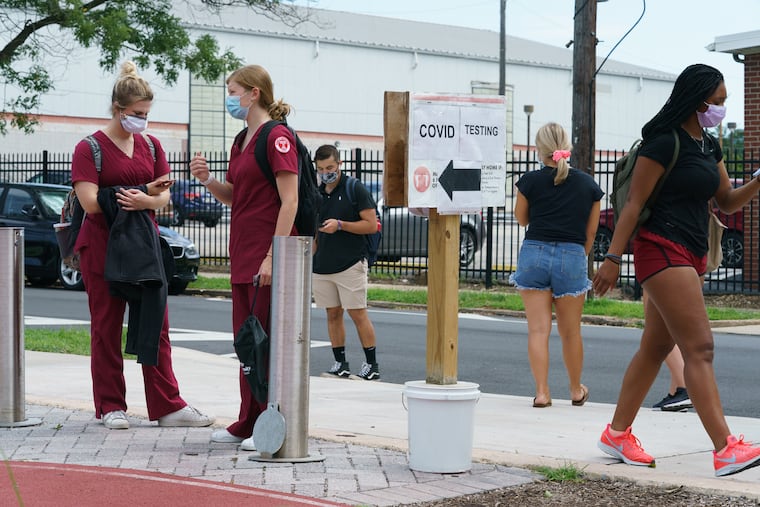Nursing students should keep training in-person during COVID-19 | Opinion
As nursing schools nationwide consider their spring plans, they should prioritize safely training student nurses in hospital settings.

The patient had been shot multiple times. In the operating room and surgical intensive care unit at Temple hospital, doctors and nurses administered emergency care. It seemed the bullets had barely missed every major organ, hitting joints rather than the chest or abdominal region. There was a leg injury, an arm injury. Under the circumstances, I learned, that qualifies as lucky.
As a Temple nursing student doing clinical rotations in the surgical ICU, I assisted with that patient’s recovery and learned a great deal from the way experienced nurses worked through the process. It was real-world preparation for my nursing career that I could never get from a textbook or simulation.
Amid the COVID-19 pandemic, every nursing school has made a decision about whether to send its students into hospitals for clinical experiences. Temple opted to safely continue this critical hands-on training, and as nursing schools nationwide consider their plans for spring, it is urgent that they prioritize safely training student nurses in hospital settings.
» READ MORE: As COVID-19 surges, Philly-area nurses describe life on the front lines: ‘It’s just exploded’
Clinical rotations—six- to 12-hour shifts learning from working nurses, and helping out as needed—have long been a requirement to earn a nursing degree. It’s no mystery why. The hospital is a unique workplace, and nursing is by nature a demanding, hands-on job. Those shifts present many diverse challenges and reflect the schedules nurses actually work.
During my regular Friday shifts in the surgical ICU, before and during the pandemic, I have practiced assessments of patients and, under supervision of staff nurses, and administered medications such as propofol, which keeps patients on ventilators sedated. Senior nursing students like myself observe procedures that physicians perform at bedside, such as bronchoscopies, placement of radial arterial lines, and insertion of chest tubes to drain fluid from a collapsed lung. For patients with brain trauma, we help monitor intracranial pressure and perform hourly neurological checks. We provide daily care and bathing of patients, and help those who aren’t on ventilators to eat and get out of bed. And I was able to see that patient with the gunshot feeling happy to return home, with a sling, after more than a week in the hospital.
My experience shows that working directly with patients as a nursing student can be done safely, even in the context of the pandemic. Doing so requires me and my classmates to be careful and responsible. Those are expectations of the profession I have chosen.
I’m not working with COVID patients in the hospital, and neither are the more than 250 other nursing students from Temple University’s College of Public Health who are continuing either hospital clinicals or fieldwork at schools, recovery centers, and other locations through a program called Community Home. That’s because we aren’t permitted to.
In the hospital, we all wear personal protective equipment, masks and gowns. It’s so important as we move from room to room and patient to patient. Some of us are double-gowning and double-gloving, an extra precaution when you have to suction non-COVID patients to make sure their airways are clear while they are on a ventilator.
Every student in a fieldwork or clinical rotation course is required to complete a class on COVID-19, and before we can report to any site we check in with an app, indicating whether we have experienced any symptoms, in which case we stay home and indicate anyone we may have been in contact with. That hasn’t been an issue for me, or other students I know. We’re staying as safe as we can, because we’ve seen the impact of COVID. We see how tired the working nurses are and so take all the precautions. I live right off campus, and really the only time I leave is to go to the hospital for my clinical. The only other students I interact with are in my clinical group. When I come home after a rotation, I wash my scrubs separately.
» READ MORE: Should medical students be allowed to work in hospitals during coronavirus? | Pro/Con
It’s not the typical college experience. Students in other fields who don’t have such direct interaction with the healthcare system may not be able to completely grasp how challenging the pandemic has been at its peaks. Making sacrifices to help other people stay healthy isn’t a difficult idea for a nursing student to understand.
Using just simulations for patient care might be safer, and we still do some of that. These simulations are not a substitute for 12-hour clinical days, but rather a supplement: a learning environment where you can develop skills, practice on a mannequin, and make mistakes harmlessly. But we also need to be prepared for the realities of practice.
» HELP US REPORT: Are you a health care worker, medical provider, government worker, patient, frontline worker or other expert? We want to hear from you.
The pandemic has exacerbated severe nursing shortages throughout the country. It’s a crisis that may grow more acute as beds and COVID wards fill up. Hospitals will need as many well-prepared nurses as they can get. My classmates and I want full training to be ready.
Aaron Wasser is a senior in Temple’s College of Public Health* and president of the Temple chapter of the Student Nurse Association of Pennsylvania.
*Editor’s note: This piece has been corrected to accurately name Aaron Wasser’s school.